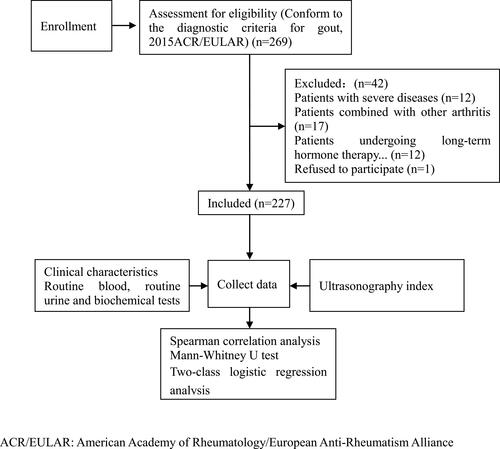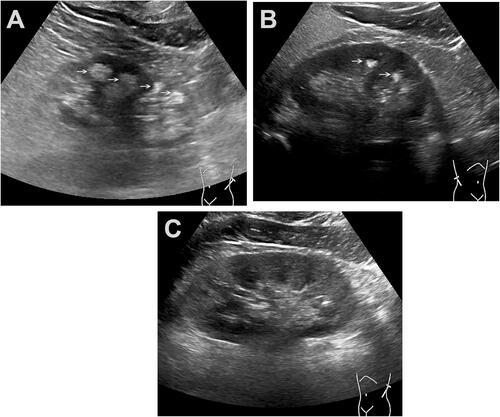Figures & data
Figure 1 CONSORT flow diagram.

Figure 2 Ultrasound examination of the kidney in a patient with gout. (A) The largest coronal surface of the kidney in the patient’s lateral position shows that the right renal medulla of the patient with gout has increased echo (indicated by the yellow arrow). (B) The largest coronal view of the kidney from a patient in lateral decubulation, showing a pyramidal stone in a patient with gout (indicated by the yellow arrow). (C) Maximum coronal view of ultrasonography kidney image of a normal patient in lateral decubitus position.

Table 1 Analysis of Clinical Characteristics and Ultrasonic Indicators of Patients with Gout
Table 2 Correlation Analysis of SUA and Ultrasonic Indexes with Laboratory Indexes
Figure 3 Logistic regression analysis of renal ultrasound parameters and laboratory indexes in patients with gout. P < 0.05: statistically significant. (A) Risk factors for renal cortical thickness, showing that disease duration, AST, CREA and tophi were risk factors of renal cortical thinning in patients with gout. [OR (95% CI) were respectively 0.872 (0.762, 0.997), 0.911 (0.84, 0.989), 0.345 (0.167, 0.713), 0.12 (0.026, 0.551)]. (B and C) Risk factors for renal medulla echo, showing that CRP and CysC are risk factors of renal hyperechogenicity of renal medulla in patients with gout [OR (95% CI) were respectively 1.029 (1.003, 1.055), 234.172 (2.218, 24725.903)].PH and GGT are protective factors of renal hyperechogenicity of renal medulla in patients with gout [OR (95% CI) were respectively 0.259 (0.096, 0.702), 0.969 (0.952, 0.986)], Among them, GGT protection factor is weak. (D and E) Risk factors for the presence of renal stones, showing that disease duration, PLT and HDL-C are the risk factors for gout patients with nephrolithiasis [OR (95% CI) were respectively 1.192 (1.01, 1.406), 1.014 (1.002, 1.027), 230.115 (2.116, 25024.194)], PH and GGT are protective factors of kidney stone formation in patients with gout [OR (95% CI) were respectively 0.185 (0.06, 0.574), 0.964 (0.946, 0.983)], Among them, GGT protection factor is weak.
![Figure 3 Logistic regression analysis of renal ultrasound parameters and laboratory indexes in patients with gout. P < 0.05: statistically significant. (A) Risk factors for renal cortical thickness, showing that disease duration, AST, CREA and tophi were risk factors of renal cortical thinning in patients with gout. [OR (95% CI) were respectively 0.872 (0.762, 0.997), 0.911 (0.84, 0.989), 0.345 (0.167, 0.713), 0.12 (0.026, 0.551)]. (B and C) Risk factors for renal medulla echo, showing that CRP and CysC are risk factors of renal hyperechogenicity of renal medulla in patients with gout [OR (95% CI) were respectively 1.029 (1.003, 1.055), 234.172 (2.218, 24725.903)].PH and GGT are protective factors of renal hyperechogenicity of renal medulla in patients with gout [OR (95% CI) were respectively 0.259 (0.096, 0.702), 0.969 (0.952, 0.986)], Among them, GGT protection factor is weak. (D and E) Risk factors for the presence of renal stones, showing that disease duration, PLT and HDL-C are the risk factors for gout patients with nephrolithiasis [OR (95% CI) were respectively 1.192 (1.01, 1.406), 1.014 (1.002, 1.027), 230.115 (2.116, 25024.194)], PH and GGT are protective factors of kidney stone formation in patients with gout [OR (95% CI) were respectively 0.185 (0.06, 0.574), 0.964 (0.946, 0.983)], Among them, GGT protection factor is weak.](/cms/asset/54715962-9744-4b85-9f43-00572556bc23/dijg_a_12168573_f0003_b.jpg)
